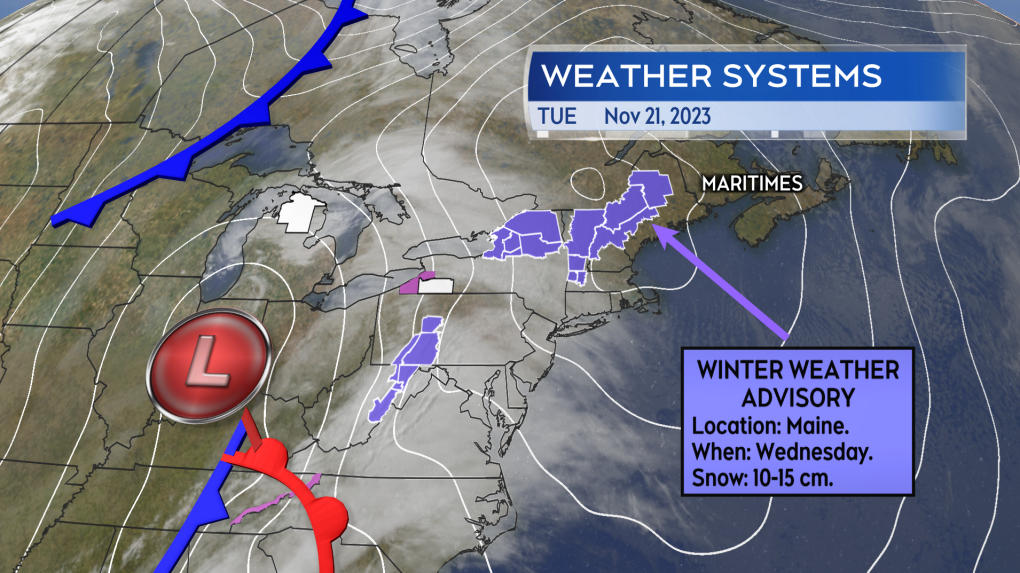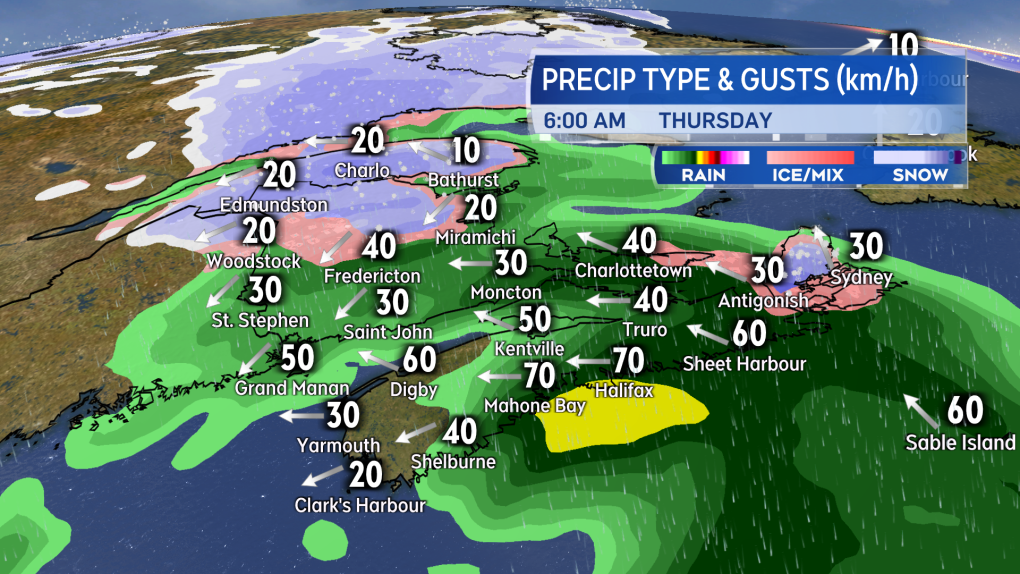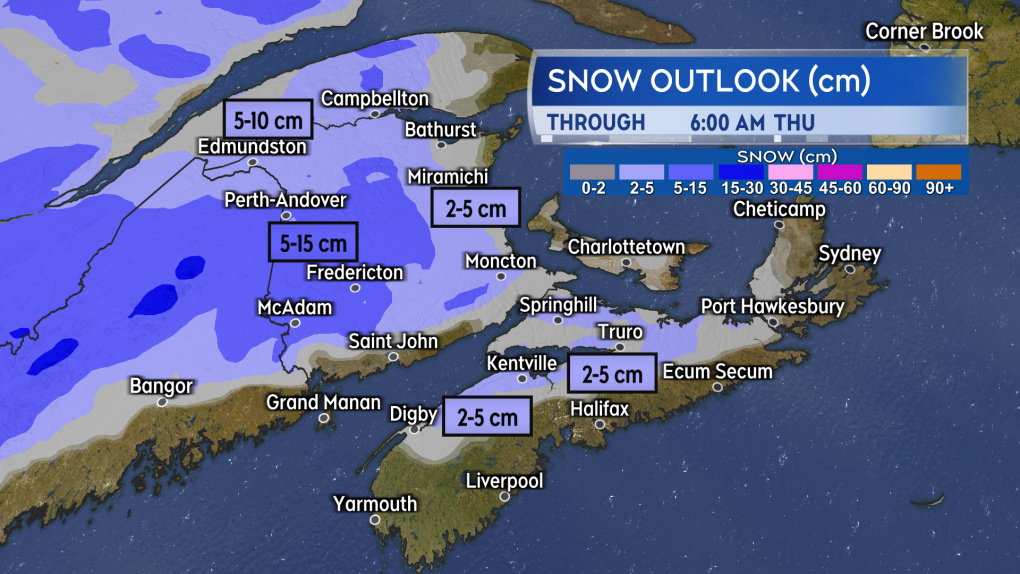Slick mix of snow and rain moves into the Maritimes Wednesday
 A dog out for a walk with its owner during a mix of rain and snow in Langford, B.C., Monday, Feb. 27, 2023. THE CANADIAN PRESS/Chad Hipolito
A dog out for a walk with its owner during a mix of rain and snow in Langford, B.C., Monday, Feb. 27, 2023. THE CANADIAN PRESS/Chad Hipolito
MAINE WINTER WEATHER ADVISORY
 Winter weather advisories issued in the northeast U.S. ahead of a system that will bring the Maritimes a mix of snow and rain.
Winter weather advisories issued in the northeast U.S. ahead of a system that will bring the Maritimes a mix of snow and rain.
A weather system is getting a lot of attention in the United States because of the impacts to their very busy travel days leading up to Thanksgiving, but it will also have some impact in the Maritimes Wednesday into Thursday.
It’s a developing low-pressure system that will push to the eastern seaboard of the U.S. Wednesday morning before passing across the southwest of Nova Scotia Thursday morning. A winter weather advisory has already been issued by the U.S. National Weather Service for parts of Maine. The advisory is calling for potential snow of 10 to 15 cm on Wednesday, creating difficult travel conditions.
SNOW AND RAIN MIX
 A mix of snow and rain develops west-to-east across the Maritimes late Wednesday morning through evening.
A mix of snow and rain develops west-to-east across the Maritimes late Wednesday morning through evening.
The Maritimes will also receive a mixture of snow and rain from the same system.
By noon on Wednesday, snow is expected to be falling across much of western New Brunswick, with rain approaching southwestern Nova Scotia. By the start of Wednesday evening, snow will be falling across most of New Brunswick, except mixed with rain south of Fredericton. Rain will be in place across the western half of mainland Nova Scotia. A wet and slushy snow is initially possible for northern areas of Nova Scotia, including parts of the Annapolis Valley, Cumberland, Colchester, and Pictou Counties. As temperatures rise Wednesday night into Thursday morning, the snow-rain line is expected to push all the way up into northern areas of New Brunswick.
 Temperatures rise Wednesday night into Thursday morning, transitioning most snow in the Maritimes over to rain and showers.
Temperatures rise Wednesday night into Thursday morning, transitioning most snow in the Maritimes over to rain and showers.
AMOUNTS AND WIND
Western areas of New Brunswick can expect the most snow from the system. Five to 15 cm is possible, except lower towards the Bay of Fundy coastline where the snow transitions to rain quicker. Snow amounts of 2 to 5 cm in eastern New Brunswick is possible before a turn to rain.
In Nova Scotia, parts of the Annapolis Valley, Cumberland, Colchester, and Pictou Counties could pick up a slushy 2 to 5 cm of snow before a turn to rain. The Cape Breton Highlands could pick up 5 to 10 cm of snow from the system. For other areas of the Maritimes, if there is some initial snow, the turn to rain is expected to limit accumulation.
 While a “wet” snow accumulation ranging up to a few to several centimetres is possible before a turn to rain, higher snow amounts approaching 10 or even 15 cm is possible for parts of western New Brunswick.
While a “wet” snow accumulation ranging up to a few to several centimetres is possible before a turn to rain, higher snow amounts approaching 10 or even 15 cm is possible for parts of western New Brunswick.
Speaking of the rain -- amounts of 30 to 50 mm are expected for the Atlantic coastal side of mainland Nova Scotia and across Cape Breton. The remainder of the Maritimes can expect rain amounts of less than 30 mm.
Wind will be gusty when some of the snow and rain comes through, but peak gusts look to be below 90 km/h, which is warning criteria. A southeast wind Wednesday will turn east Thursday night. The peak gusts for Nova Scotia and the Bay of Fundy coastline will range 40 to 70 km/h Wednesday night. The rest of the Maritimes will see gusts of 20 to 50 km/h.
CTVNews.ca Top Stories

W5 Investigates A 'ticking time bomb': Inside Syria's toughest prison holding accused high-ranking ISIS members
In the last of a three-part investigation, W5's Avery Haines was given rare access to a Syrian prison, where thousands of accused high-ranking ISIS members are being held.
'Mayday!': New details emerge after Boeing plane makes emergency landing at Mirabel airport
New details suggest that there were communication issues between the pilots of a charter flight and the control tower at Montreal's Mirabel airport when a Boeing 737 made an emergency landing on Wednesday.
BREAKING Supreme Court affirms constitutionality of B.C. law on opioid health costs recovery
Canada's top court has affirmed the constitutionality of a law that would allow British Columbia to pursue a class-action lawsuit against opioid providers on behalf of other provinces, the territories and the federal government.
Cucumbers sold in Ontario, other provinces recalled over possible salmonella contamination
A U.S. company is recalling cucumbers sold in Ontario and other Canadian provinces due to possible salmonella contamination.
Irregular sleep patterns may raise risk of heart attack and stroke, study suggests
Sleeping and waking up at different times is associated with an increased risk of heart attack and stroke, even for people who get the recommended amount of sleep, according to new research.
Real GDP per capita declines for 6th consecutive quarter, household savings rise
Statistics Canada says the economy grew at an annualized pace of one per cent during the third quarter, in line with economists' expectations.
Nick Cannon says he's seeking help for narcissistic personality disorder
Nick Cannon has spoken out about his recent diagnosis of narcissistic personality disorder, saying 'I need help.'
California man who went missing for 25 years found after sister sees his picture in the news
It’s a Thanksgiving miracle for one California family after a man who went missing in 1999 was found 25 years later when his sister saw a photo of him in an online article, authorities said.
As Australia bans social media for children, Quebec is paying close attention
As Australia moves to ban social media for children under 16, Quebec is debating whether to follow suit.


































